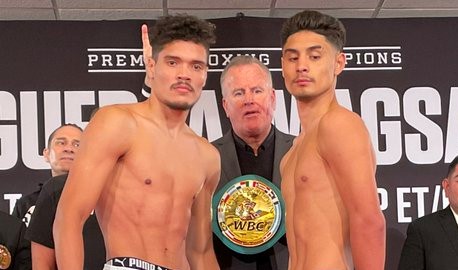By: Jesse Donathan
News broke late Tuesday evening, April 16, 2019 that heavyweight contender Jarrell Miller has tested positive for the banned substance GW1516, putting his June 1 Madison Square Garden showdown with heavyweight champion Anthony Joshua in jeopardy according to a cbssports.com article by Jack Maloney titled “Report: Jarrell ‘Big Baby’ Miller fails VADA test before heavyweight title fight vs. Anthony Joshua.”
According to an ESPN report, “Sources: Miller, set to face Joshua, fails drug test” columnist Dan Rafael writes that, “GW1516, also known as Cardarine and Endurobol, is on the World Anti-Doping Agency’s banned list and is classified as a metabolic modulator. An athlete might use it to assist in fat loss or use it as an endurance booster.”
The world of performance enhancing drug use is a familiar one to athletes virtually across the board in sporting competition. Whenever winning counts, there will be competitors looking for any and all advantages over their opponents. It’s an instinct inherent within the human experience, survival of the fittest, where only the strong survive. And as the old adage goes, if you’re not cheating, you’re not trying.

Competition in sport harnesses that primal instinct to win, to survive, and manifests itself in a variety of forms of sport where society rewards the best with a nearly god like status while reserving all others as mere mortals in the presence of said greatness. Whoever that may be in your respective sport of choice, whether its Tiger Woods or the great Michael Jordan.
“In order to try to evade detection, athletes who continue to dope are having to resort to the use of a far more dangerous form of drug – the designer steroid,” writes Ray Kazlauskas in his September 17, 2009 link.springer.com abstract titled, “Designer Steroids.”
According to Kazlauskas, “These steroids are manufactured to closely resemble existing known compounds, but with sufficient chemical diversity to ensure that their detection by the WADA accredited laboratories is more difficult.”
As you may have already surmised, there are known illegal substances and unknown illegal substances. These designer steroids that are of unknown compositions are difficult to detect because the tests administered to athletes are designed to look for specific markers only. The world of anti-doping testing is constantly having to evolve their methodology and understanding of performance enhancing drugs in order to keep up with the evolution of science.
And just as there are illegal performance enhancing drugs, there are legal performance enhancing drugs as well.
Creatine being one of the more popular legal substances on the market today which is regularly used by athletes in order to increase muscle mass and improve athletic performance according to an NIH U.S. National Library of Medicine medlineplus.gov report.
Of course, what constitutes a legal and illegal substance depends very much on what set of rules you’re operating under, though there does seem to be some overlap with a variety of major anti-doping agencies.
“Of eight runners,” Spiegel asks Angel Heredia, former coach to Olympian Marion Jones while hypothetically discussing the 2008 Beijing Olympics, there “will be eight doped,” responds Heredia as Spiegel is obligated to then point out that he cannot actually prove it. “Its undoubtedly like that,” responds Heredia in a November 8, 2008 Spiegel online interview titled, “The Dealer Olympias.” What this should mean to every combat sports fan reading is that many if not all of the elite athletes in sports today are using performance enhancing drugs to one degree or another.
Mexican boxing phenom Canelo Alvarez famously tested positive for clenbuterol in 2018 ahead of his highly anticipated rematch with Gennady Golovkin. “Clenbuterol has shown up in drug tests for many Mexican athletes in recent years because of meat contamination in the country. Alvarez also said meat contamination caused his positive test,” writes ESPN reporter Dan Rafael in his March 6, 2018 ESPN.com article, “Canelo Alvarez’s camp blames suspect meat for positive clenbuterol test.”
Searching for more information, it turns out an August 27, 1995 NCBI U.S. National Library of Medicine abstract titled “Clenbuterol: a substitute for anabolic steroids” states that, “Clenbuterol is a recently popular drug used by athletes in many sports for its purported anabolic effects and reduction of subcutaneous fat. It is a beta-2 (beta 2) agonist prescribed overseas as a bronchodilator, but not approved for use in this country. It is on the banned substance list of the United States Olympic Committee.”
In a March 14, 2019 LA Times article titled “Victor Conte, of BALCO fame, has found a new home in boxing” author Dylan Hernandez writes “Only in what Conte described as the “red-light district of sport” can a convicted steroid distributor be part of a high-profile event and do so in full view of the public.
“I was banned everywhere else,” Conte said with a chuckle. Now a vocal advocate for year-round drug testing, the self-educated former BALCO mastermind helped lightweight champion Mikey Garcia move up to the heavier welterweight division for his showdown with hard-punching Errol Spence.”
According to Hernandez, “Conte, 68, spent four months in prison in 2005 for his role in the BALCO scandal, which tarnished the reputations of high-profile athletes such as Barry Bonds and Marion Jones.” Only a fool would think the Mikey Garcia camp went to Conte for anything but performance enhancing drug use. “We’re clean,” Garcia told the LA Times. The author would go on to state that, “Garcia and his trainer-brother have talked openly about their work with Conte, insisting they have nothing to hide.”
And they may very well not have anything to hide, if you follow the rule book and avoid banned, prohibited substances. However, that does not mean Conte isn’t riding on the cutting edge of science and technology, obviously his milkshakes are still bringing all the boys to yard. So, it is highly doubtful the Garcia camp is going to Conte for fish oil and creatine supplements.
Undoubtably, there are going to be those who decry that science has given us an endless bounty of performance enhancing substances to make athletes bigger, stronger and faster yet we are purposely suppressing this fountain of knowledge and entertainment to our own expense.
The cold, hard reality is that the fairy tale world of fairness, sportsmanship and a level playing field have joined forces with a multi-million-dollar regulation industry to ensure that a cat and mouse like game continues in order to keep the fines and penalties associated with prohibited banned substances rolling in.
Mixed martial arts referee “Big” John McCarthy famously said this is the hurt business. And in the hurt business people get hurt. The amount of damage and sacrifice these athletes make is incalculable, their lives and future very much at stake and on the line as they train to chase a dream that has customarily chewed up and spit out many greats before them.
Modern medicine and science exist to help these athletes perform to the best of their abilities, yet there is an entire industry developed to ensure these athletes do not take advantage of every possible opportunity to protect themselves in the ring, cage or field of play. And its justified under a false pretense that the rest of the field is clean, while it’s a select few bad guys ruining the sport for everyone else. Meanwhile, there is an entire industry profiting from a fairy tale, false belief perpetuated by those raking in the dough as a result of continued, sustained regulation.
Though I am not for or against the use of performance enhancing drugs in combat sports, believing it to be a deeply complicated subject and one without a clear right and wrong answer, I am absolutely in favor of a fair, level playing field. I do not however subscribe to the naïve paradigm espoused by most casual observers that the baseline truth is that the vast majority of elite athletes in professional combat sports today are clean. I simply do not believe that to be case and neither should you.
While there may be some outliers, naturally gifted athletes with the physical attributes and athletic ability to compete at an elite level without the aid of performance enhancing drugs the continued and sustained number of athletes regularly popping for banned, prohibited substances suggests the use of performance enhancing drugs is endemic within combat sports due to the very nature of the sports themselves and a new paradigm of regulation and enforcement is needed in order to adjust to the realities of combat sporting competition.
The naïve, fairy tale ramblings of those who seem to concern themselves with matters in which know very little about need to be recognized for what they are and filtered through the lens of common sense that suggest combat sports are an entirely different animal to non-contact sports. And the realities associated their participation need to be taken into account when dealing with how these athletes treat their bodies and live their lives. Its time for a new paradigm shift in how performance enhancing drugs are regulated in combat sports.


















